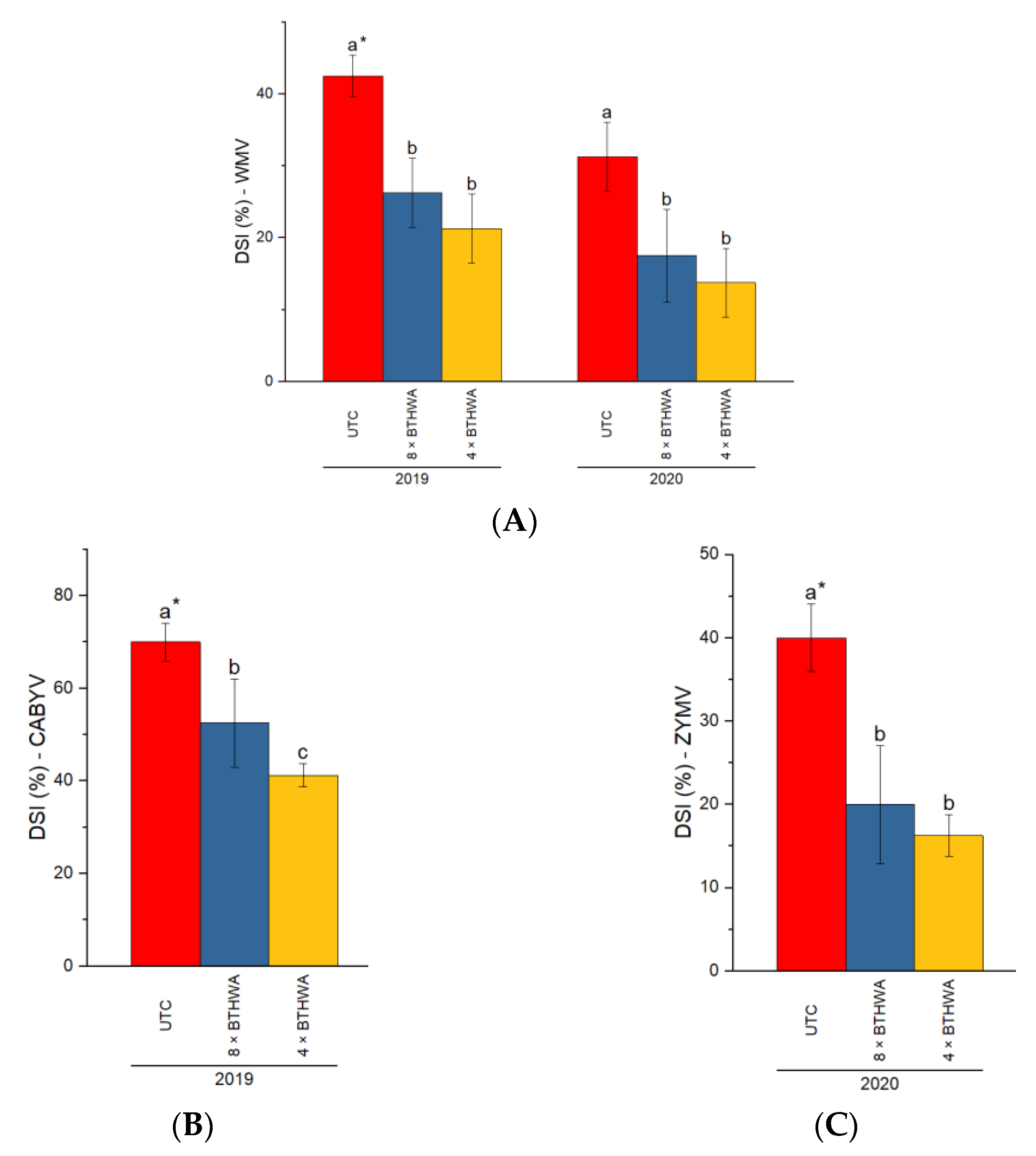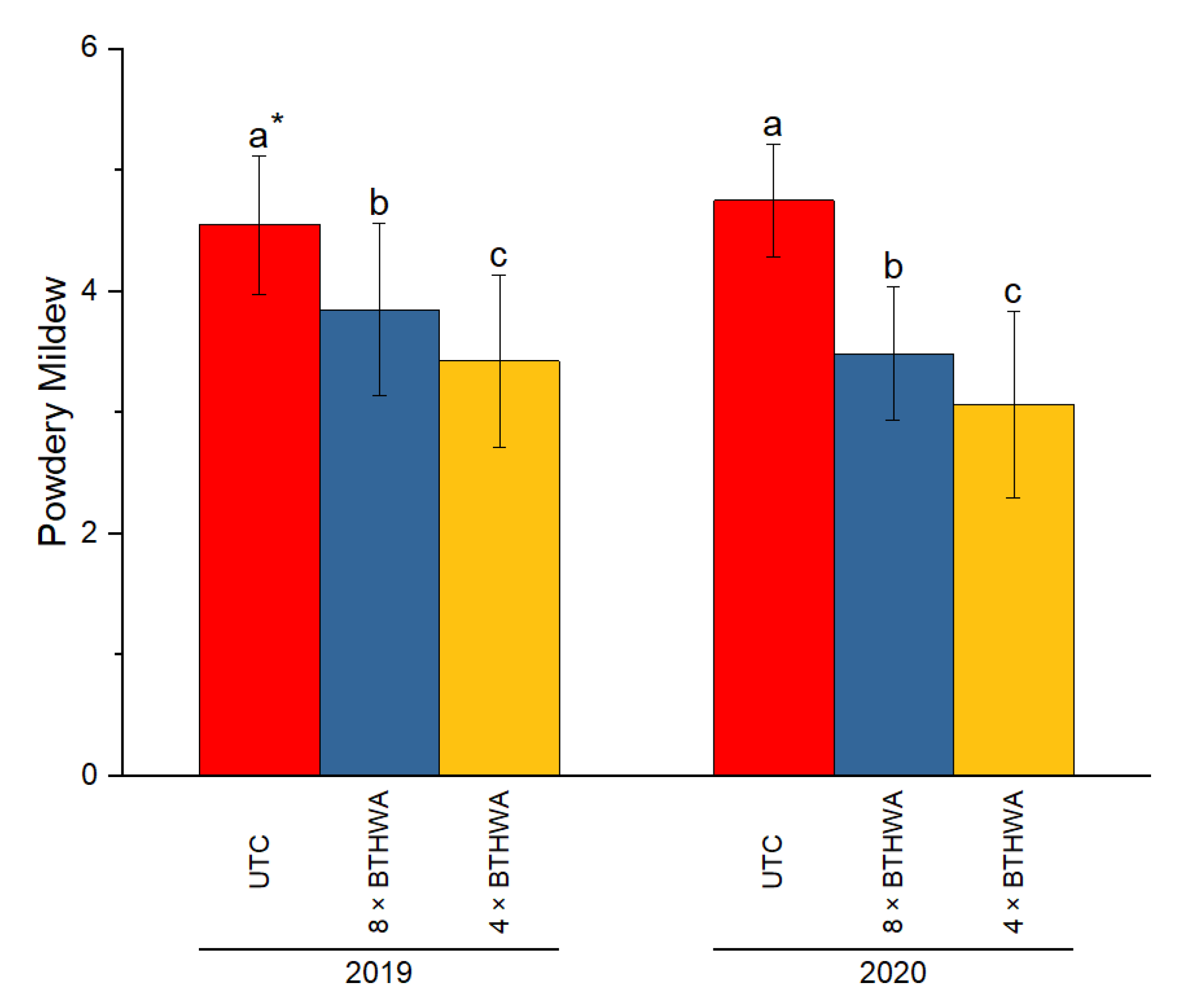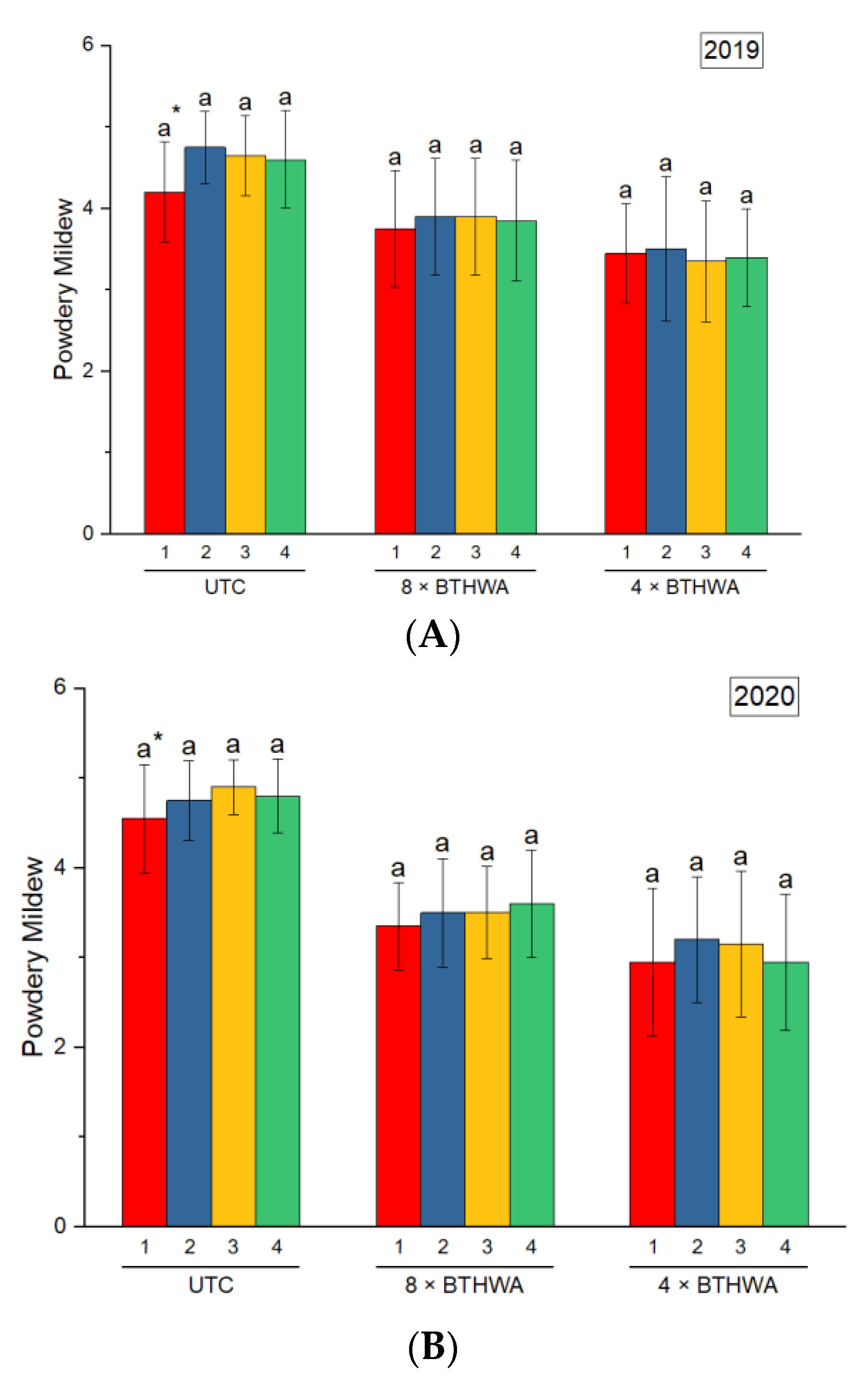A New Benzothiadiazole Derivative with Systemic Acquired Resistance Activity in the Protection of Zucchini (Cucurbita pepo convar. giromontiina) against Viral and Fungal Pathogens
Abstract
1. Introduction
2. Results
3. Discussion
4. Materials and Methods
4.1. Tested Substance
4.2. Experimental Design
4.3. Assessment of Powdery Mildew Infection
4.4. Assessment of Viral Pathogens Infection
4.5. Assessment of Pathogens Infection
4.6. Statistical Analysis
Supplementary Materials
Author Contributions
Funding
Data Availability Statement
Conflicts of Interest
References
- Montero-Pau, J.; Blanca, J.; Bombarely, A.; Ziarsolo, P.; Esteras, C.; Martí-Gómez, C.; Ferriol, M.; Gómez, P.; Jamilena, M.; Mueller, L.; et al. De novo assembly of the zucchini genome reveals a whole-genome duplication associated with the origin of the Cucurbita genus. Plant Biotechnol. J. 2018, 16, 1161–1171. [Google Scholar] [CrossRef] [PubMed]
- Blanco-Díaz, M.T.; Del Río-Celestino, M.; Martínez-Valdivieso, D.; Font, R. Use of Visible and Near-Infrared Spectroscopy for Predicting Antioxidant Compounds in Summer Squash (Cucurbita Pepo ssp. Pepo). Food Chem. 2014, 164, 301–308. [Google Scholar] [CrossRef] [PubMed]
- Martínez-Valdivieso, D.; Font, R.; Fernández-Bedmar, Z.; Merinas-Amo, T.; Gómez, P.; Alonso-Moraga, Á.; del Río-Celestino, M. Role of Zucchini and Its Distinctive Components in the Modulation of Degenerative Processes: Genotoxicity, Anti-Genotoxicity, Cytotoxicity and Apoptotic Effects. Nutrients 2017, 9, 755. [Google Scholar] [CrossRef] [PubMed]
- Iswaldi, I.; Gomez-Caravaca, A.M.; Lozano-Sanchez, J.; Arraez-Roman, D.; Segura-Carretero, A.; Fernandez-Gutierrez, A. Profiling of phenolic and other polar compounds in zucchini (Cucurbita pepo L.) by reverse-phase high-performance liquid chromatography coupled to quadrupole time-of-flight mass spectrometry. Food Res. Int. 2013, 50, 77–84. [Google Scholar] [CrossRef]
- Møller, P.; Loft, S. Interventions with Antioxidants and Nutrients in Relation to Oxidative DNA Damage and Repair. Mutat. Res. Fundam. Mol. Mech. Mutagen. 2004, 551, 79–89. [Google Scholar] [CrossRef]
- Pirone, T.P.; Perry, K.L. Aphids: Non-persistent transmission. Adv. Bot. Res. 2002, 36, 1–19. [Google Scholar]
- Khanal, V.; Wells, H.; Ali, A. High Prevalence of Three Potyviruses Infecting Cucurbits in Oklahoma and Phylogenetic Analysis of Cucurbit Aphid-Borne Yellows Virus Isolated from Pumpkins. Pathogens 2021, 10, 53. [Google Scholar] [CrossRef]
- Crescenzi, A.; Fanigliulo, A.; Comes, S.; Masenga, V.; Pacella, R.; Piazzolla, P. Necrosis of watermelon caused by Watermelon mosaic virus. J. Plant Pathol. 2001, 83, 227. [Google Scholar]
- Lecoq, H.; Desbiez, C. Viruses of cucurbit crops in the Mediterranean region: An ever-changing picture. Adv. Virus Res. 2012, 84, 67–126. [Google Scholar]
- Lecoq, H.; Bourdin, D.; Wipf-Scheibel, C.; Bon, M.; Lot, H.; Lemaire, O.; Herrbach, E. A New Yellowing Disease of Cucurbits Caused by a Luteovirus, Cucurbit Aphid-borne Yellows Virus. Plant Pathol. 1992, 41, 749–761. [Google Scholar] [CrossRef]
- Tanaka, K.; Fukuda, M.; Amaki, Y. Importance of prumycin produced by Bacillus amyloliquefaciens SD-32 in biocontrol against cucumber powdery mildew disease. Pest Manag. Sci. 2017, 73, 2419–2428. [Google Scholar] [CrossRef]
- El-Naggar, M.; El-Deeb, H.; Ragab, S. Applied approach for controlling powdery mildew disease of cucumber under plastic houses. Pak. J. Agric. Agric. Eng. Vet. Sci. 2012, 28, 54–64. [Google Scholar]
- Zitter, T.A. Cucurbit diseases. In Compendium of Cucurbit Diseases; Zitter, T.A., Hopkins, D.L., Thomas, C.E., Eds.; APS Press: St. Paul, MN, USA, 1996; pp. 1–2. [Google Scholar]
- Sitterly, W.R. Powdery mildews of Cucurbits. In The Powdery Mildews; Spencer, D.M., Ed.; Academic Press Inc.: New York, NY, USA, 1978; pp. 359–379. [Google Scholar]
- Juroszek, P.; Von Tiedemann, A. Potential Strategies and Future Requirements for Plant Disease Management under a Changing Climate. Plant Pathol. 2011, 60, 100–112. [Google Scholar] [CrossRef]
- Commission Implementing Regulation (Eu) 2015/408,2015. Available online: https://eur-lex.europa.eu/legal-content/EN/TXT/PDF/?uri=CELEX:32015R0408, (accessed on 19 December 2022).
- Zajac, A.; Kukawka, R.; Pawlowska-Zygarowicz, A.; Stolarska, O.; Smiglak, M. Ionic Liquids as Bioactive Chemical Tools for Use in Agriculture and the Preservation of Agricultural Products. Green Chem. 2018, 20, 4764–4789. [Google Scholar] [CrossRef]
- Kiraly, L.; Barnaz, B.; Kiralyz, Z. Plant Resistance to Pathogen Infection: Forms and Mechanisms of Innate and Acquired Resistance. J. Phytopathol. 2007, 155, 385–396. [Google Scholar] [CrossRef]
- Shine, M.B.; Xiao, X.; Kachroo, P.; Kachroo, A. Signaling Mechanisms Underlying Systemic Acquired Resistance to Microbial Pathogens. Plant Sci. 2019, 279, 81–86. [Google Scholar] [CrossRef]
- Schurter, R.; Kunz, W.; Nyfeler, R. Process and A Composition for Immunizing Plants against Diseases. U.S. Patent No. 4931581, 5 June 1990. [Google Scholar]
- Friedrich, L.; Lawton, K.; Dincher, S.S.; Winter, A.; Staub, T.; Uknes, S.; Kessmann, H.; Ryals, J. Benzothiadiazole Induces Systemic Acquired Resistance in Tobacco. Plant J. 1996, 10, 61–70. [Google Scholar] [CrossRef]
- Lin, T.C.; Ishizaka, M.; Ishii, H. Acibenzolar-S-Methyl-Induced Systemic Resistance against Anthracnose and Powdery Mildew Diseases on Cucumber Plants without Accumulation of Phytoalexins. J. Phytopathol. 2009, 157, 40–50. [Google Scholar] [CrossRef]
- Harel, Y.M.; Kolton, M.; Elad, Y.; Rav-david, D.; Cytryn, E.; Borenstein, M.; Shulchani, R.; Graber, E.R. Induced systemic resistance in strawberry (Fragaria ananassa) to powdery mildew using various control agents. IOBC/Wprs. Bull. 2011, 71, 47–51. [Google Scholar]
- Görlach, J.; Volrath, S.; Knauf-Beiter, G.; Hengy, G.; Beckhove, U.; Kogel, K.H.; Oostendorp, M.; Staub, T.; Ward, E.; Kessmann, H.; et al. Benzothiadiazole, a Novel Class of Inducers of Systemic Acquired Resistance, Activates Gene Expression and Disease Resistance in Wheat. Plant Cell 1996, 8, 629–643. [Google Scholar] [CrossRef]
- Smiglak, M.; Kukawka, R.; Lewandowski, P.; Pospieszny, H. Cationic Derivatives of the Plant Resistance Inducer Benzo[1,2,3] Thiadiazole-7-Carbothioic Acid S-Methyl Ester (BTH) as Bifunctional Ionic Liquids. Tetrahedron Lett. 2014, 55, 3565–3568. [Google Scholar] [CrossRef]
- Kukawka, R.; Czerwoniec, P.; Lewandowski, P.; Pospieszny, H.; Smiglak, M. New Ionic Liquids Based on Systemic Acquired Resistance Inducers Combined with the Phytotoxicity Reducing Cholinium Cation. New J. Chem. 2018, 42, 11984–11990. [Google Scholar] [CrossRef]
- Feder-Kubis, J.; Czerwoniec, P.; Lewandowski, P.; Pospieszny, H.; Smiglak, M. Ionic Liquids with Natural Origin Component: A Path to New Plant Protection Products. ACS Sustain. Chem. Eng. 2020, 8, 842–852. [Google Scholar] [CrossRef]
- Smiglak, M.; Kukawka, R.; Lewandowski, P.; Budziszewska, M.; Obrepalska-Steplowska, A.; Krawczyk, K.; Zwolińska, A.; Pospieszny, H. New Dual Functional Salts Based on Cationic Derivative of Plant Resistance Inducer-Benzo[1.2.3]Thiadiazole-7-Carbothioic Acid, S-Methyl Ester. ACS Sustain. Chem. Eng. 2016, 4, 3344–3351. [Google Scholar] [CrossRef]
- Smiglak, M.; Lewandowski, P.; Kukawka, R.; Budziszewska, M.; Krawczyk, K.; Obrępalska-Stęplowska, A.; Pospieszny, H. Dual Functional Salts of Benzo[1.2.3]Thiadiazole-7-Carboxylates as a Highly Efficient Weapon Against Viral Plant Diseases. ACS Sustain. Chem. Eng. 2017, 5, 4197–4204. [Google Scholar] [CrossRef]
- Markiewicz, M.; Lewandowski, P.; Spychalski, M.; Kukawka, R.; Feder-Kubis, J.; Beil, S.; Smiglak, M.; Stolte, S. New Bifunctional Ionic Liquid-Based Plant Systemic Acquired Resistance (SAR) Inducers with an Improved Environmental Hazard Profile. Green Chem. 2021, 23, 5138–5149. [Google Scholar] [CrossRef]
- Frackowiak, P.; Pospieszny, H.; Smiglak, M.; Obrępalska-Stęplowska, A. Assessment of the Efficacy and Mode of Action of Benzo(1,2,3)-Thiadiazole-7-Carbothioic Acid s-Methyl Ester (Bth) and Its Derivatives in Plant Protection against Viral Disease. Int. J. Mol. Sci. 2019, 20, 1598. [Google Scholar] [CrossRef]
- European and Mediterranean Plant Protection Organisation. PP1 1/057 (3) Evaluation of plant protection products (PP 1).Efficacy evaluation of fungicides. Powdery mildew on cucurbits and other vegetables. EPPO Bull. 2005, 2, 78–82. [Google Scholar]
- Roubos, C.R.; Rodriguez-Saona, C.; Isaacs, R. Mitigating the Effects of Insecticides on Arthropod Biological Control at Field and Landscape Scales. Biol. Control 2014, 75, 28–38. [Google Scholar] [CrossRef]
- Zarzyńska-Nowak, A.; Hasiów-Jaroszewska, B.; Budzyńska, D.; Borodynko-Filas, N. First report of cucurbit aphid-borne yellows virus infecting zucchini plants (Cucurbita pepo convar. giromontiina) in Poland. Plant Dis. 2019, 103, 1047. [Google Scholar] [CrossRef]
- Hasiów-Jaroszewska, B.; Chrzanowski, M.; Budzyńska, D.; Rymelska, N.; Borodynko-Filas, N. Genetic Diversity, Distant Phylogenetic Relationships and the Occurrence of Recombination Events among Cucumber Mosaic Virus Isolates from Zucchini in Poland. Arch. Virol. 2017, 162, 1751–1756. [Google Scholar] [CrossRef] [PubMed]
- Walters, D.R.; Ratsep, J.; Havis, N.D. Controlling Crop Diseases Using Induced Resistance: Challenges for the Future. J. Exp. Bot. 2013, 64, 1263–1280. [Google Scholar] [CrossRef]
- Lozano-Durán, R.; Zipfel, C. Trade-off between Growth and Immunity: Role of Brassinosteroids. Trends Plant Sci. 2015, 20, 12–19. [Google Scholar] [CrossRef]
- Albrecht, T.; Argueso, C.T. Should I Fight or Should I Grow Now? The Role of Cytokinins in Plant Growth and Immunity and in the Growth-Defence Trade-Off. Ann. Bot. 2017, 119, 725–735. [Google Scholar] [CrossRef] [PubMed]
- Yu, M.H.; Zhao, Z.Z.; He, J.X. Brassinosteroid Signaling in Plant–Microbe Interactions. Int. J. Mol. Sci. 2018, 19, 4091. [Google Scholar] [CrossRef]
- van Butselaar, T.; Van den Ackerveken, G. Salicylic Acid Steers the Growth–Immunity Tradeoff. Trends Plant Sci. 2020, 25, 566–576. [Google Scholar] [CrossRef] [PubMed]
- Spychalski, M.; Kukawka, R.; Krzesiński, W.; Spiżewski, T.; Michalecka, M.; Poniatowska, A.; Puławska, J.; Mieszczakowska-Frąc, M.; Panasiewicz, K.; Kocira, A.; et al. Use of New BTH Derivative as Supplement or Substitute of Standard Fungicidal Program in Strawberry Cultivation. Agronomy 2021, 11, 1031. [Google Scholar] [CrossRef]
- Huang, C.H.; Vallad, G.E.; Zhang, S.; Wen, A.; Balogh, B.; Figueiredo, J.F.L.; Behlau, F.; Jones, J.B.; Timur Momol, M.; Olson, S.M. Effect of Application Frequency and Reduced Rates of Acibenzolar-S-Methyl on the Field Efficacy of Induced Resistance against Bacterial Spot on Tomato. Plant Dis. 2012, 96, 221–227. [Google Scholar] [CrossRef]
- Smiglak, M.; Pospieszny, H.; Kukawka, R.; Lewandowski, P.; Stolarska, O.; Maciejewski, H. Application of 7-Carboxybenzo(1,2,3)ThiadiazoleAmides as Plant. Stimulants. Patent Application No. WO/2017/017626, 2 February 2017. [Google Scholar]
- Clark, M.F.; Adams, A.N. Characteristics of the Microplate Method of Enzyme Linked Immunosorbent Assay for the Detection of Plant Viruses. J. Gen. Virol. 1977, 34, 475–483. [Google Scholar] [CrossRef]
- Chaube, H.S.; Singh, U.S. Plant Disease Management: Principles and Practices, 1st ed.; CRC Press: Boca Raton, FL, USA, 1991; p. 335. [Google Scholar]
- Bock, C.H.; Chiang, K.S.; Del Ponte, E.M. Accuracy of plant specimen disease severity estimates: Concepts, history, methods, ramifications and challenges for the future. CAB Rev. Pers. Ag. Vet. Sci. Nutr. Nat. Res. 2016, 11, 1–13. [Google Scholar] [CrossRef]




Disclaimer/Publisher’s Note: The statements, opinions and data contained in all publications are solely those of the individual author(s) and contributor(s) and not of MDPI and/or the editor(s). MDPI and/or the editor(s) disclaim responsibility for any injury to people or property resulting from any ideas, methods, instructions or products referred to in the content. |
© 2022 by the authors. Licensee MDPI, Basel, Switzerland. This article is an open access article distributed under the terms and conditions of the Creative Commons Attribution (CC BY) license (https://creativecommons.org/licenses/by/4.0/).
Share and Cite
Spychalski, M.; Kukawka, R.; Prasad, R.; Borodynko-Filas, N.; Stępniewska-Jarosz, S.; Turczański, K.; Smiglak, M. A New Benzothiadiazole Derivative with Systemic Acquired Resistance Activity in the Protection of Zucchini (Cucurbita pepo convar. giromontiina) against Viral and Fungal Pathogens. Plants 2023, 12, 43. https://doi.org/10.3390/plants12010043
Spychalski M, Kukawka R, Prasad R, Borodynko-Filas N, Stępniewska-Jarosz S, Turczański K, Smiglak M. A New Benzothiadiazole Derivative with Systemic Acquired Resistance Activity in the Protection of Zucchini (Cucurbita pepo convar. giromontiina) against Viral and Fungal Pathogens. Plants. 2023; 12(1):43. https://doi.org/10.3390/plants12010043
Chicago/Turabian StyleSpychalski, Maciej, Rafal Kukawka, Raghavendra Prasad, Natasza Borodynko-Filas, Sylwia Stępniewska-Jarosz, Krzysztof Turczański, and Marcin Smiglak. 2023. "A New Benzothiadiazole Derivative with Systemic Acquired Resistance Activity in the Protection of Zucchini (Cucurbita pepo convar. giromontiina) against Viral and Fungal Pathogens" Plants 12, no. 1: 43. https://doi.org/10.3390/plants12010043
APA StyleSpychalski, M., Kukawka, R., Prasad, R., Borodynko-Filas, N., Stępniewska-Jarosz, S., Turczański, K., & Smiglak, M. (2023). A New Benzothiadiazole Derivative with Systemic Acquired Resistance Activity in the Protection of Zucchini (Cucurbita pepo convar. giromontiina) against Viral and Fungal Pathogens. Plants, 12(1), 43. https://doi.org/10.3390/plants12010043





